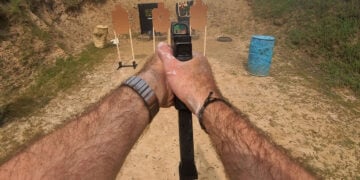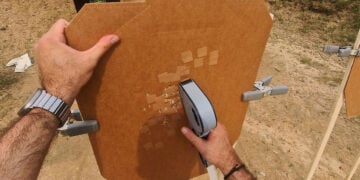Hand skills are a must for anyone serious about self-defense, which includes the Non-Confrontational Stance. Here I wish to discuss one of the most important elements of hand skills as it applies to the average citizen, and that is the ability to handle a hostile confrontation right from the onset of the event. The biggest danger in an actual physical altercation is being disabled with a strike before you can react to defend yourself. A powerful blow that finds its mark can take you out of the fight before it begins, leaving you helpless and at the mercy of your attacker even if you are armed.
Avoid the Face-Off
Most fights start as a dispute of some kind. There are also criminal assaults that begin as a complete ambush and training to have immediate reactionary techniques to these are also important. Here, though, I wish to focus on the techniques appropriate for mitigating a confrontation that usually starts verbally as an argument or when someone aggressively approaches you, perhaps on the street. You probably have all witnessed a common occurrence for such an altercation: two guys get into a heated confrontation, and one or both parties approach the other, chest puffed out, in an intimidating manner, and stands right in the other’s personal space, face-to-face. Lot’s of testosterone present, but very little intellect.
Now, when an adversary does this, it is actually very intimidating because our primal lizard brain that controls our fight-or-flight response associates this posturing with the animal kingdom, or something that is primitive. After all, who does this? Bears, gorillas, and the like. Apparently untrained men also. It is psychologically intimidating, and this is why men tend to do this by nature. A considerable percentage of these standoffs end when one party sucker-punches the other. Both fools stand staring each other down and leaving themselves wide open for a strike. Whoever hits first can land a good shot.
The Non-Confrontational Stance
The best fighting position that the human body can default to if under threat is the one that it wants to do naturally. This is usually the non-confrontational stance. This position consists of the arms taking on a triangular-like position with fingers splayed (not clenched in fists) and palms forward. Weight is leaning forward in the balls of the feet, and one leg goes slightly behind the other for stability. There are two benefits to this stance. First, it actually appears to be “non-confrontational,” and you look as if you don’t want to fight and wish to de-escalate. Second, it is the strongest possible defensive posture your body can assume.
Think about this, if you unexpectedly throw a ball at someone’s face, what posture do they assume with their arms? Do they clench their hands into fists? No, the body takes on this position with the triangular arms, hands open, to push away danger. This is often called the flinch response. If a friend charges and crashes into you when playing a rough game, how does your body react? Without any conscious thought at all? You push away the danger with open hands in this position, and you instinctively place one leg behind the other to brace for impact. This stance is nature’s fighting stance, and it is a good default position to be in.
The Fence Principle
As good guys, we usually can’t just hit somebody. There are exceptions in which preemptive strikes are legally appropriate, but often, we are forced to react to an action. That already puts us behind the power curve, but it is our reality. The concept known in combatives as “the fence” builds on the non-confrontational stance. Having the hands up, fingers splayed and palms forward builds a fence against any sneaky shots that the adversary will try to land on you. Typically an opponent will not launch blows directly into your hands. He is going to look for an opening. Therefore, you are unlikely to encounter a straight-line punch if using the fence.
Instead, the roundhouse or haymaker punch is what you are most likely to receive. With the fence up you are far more capable of blocking this blow before it arrives. With your hands down, as they would be in the chest puffing posture, you will never intercept this shot. The haymaker roundhouse punch is the most common one we witness in the streets.
The fence also puts you in position to effectively counter most other frontal assaults that you may experience. For example, the ever-popular lapel grab, in which an adversary grabs you by the shirt, actually does happen. But not in the static, single-handed manner seen demonstrated in the commercialized dojos across the land. An adversary will grab your shirt for a reason. Perhaps a two-handed grab to control you. Or a one-handed grab to trap you so that he can strike you with the other hand. Having the fence up makes his ability to place hands on you harder in the first place. If he does get a hand on you, the fence puts you in the position for immediate counter-assault.
Conclusion
The non-confrontational stance is ideal for any situation in which you are facing a potential threat. It looks like you don’t want to fight, which gives you a tactical advantage. And it is the best default position to be in to withstand an assault. This is the stance you want to implement from the outset. Let’s say a suspicious individual approaches you while in the streets. This is an excellent position to take even well before the individual gets close to you. If an aggressor gets in your face to do the typical “face-off” then certainly take the non-confrontational stance. It is the best way to de-escalate, if possible, but it is also the ideal position for self-defense.










“Lot’s of testosterone present, but very little intellect.”
It seems like some intellect would be able to do 4-letter words correctly.